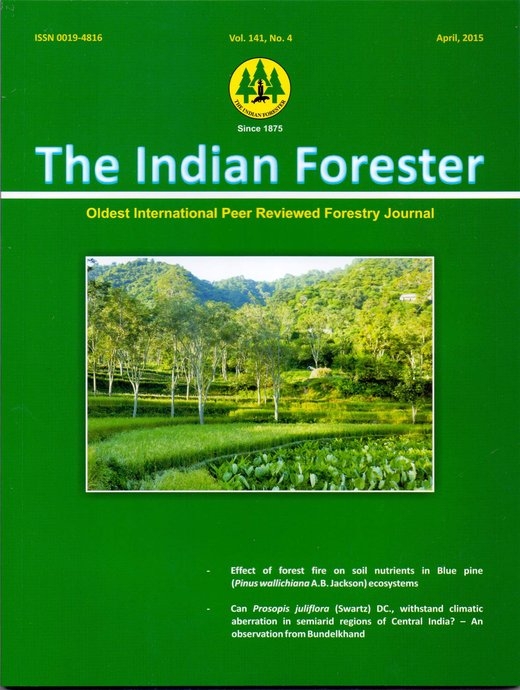Amelioration of Phenol Formaldehyde Adhesive With Silicic Acid for Application in Plywood
DOI:
https://doi.org/10.36808/if/2015/v141i4/68794Keywords:
Glue Shear Strength, Phenol Formaldehyde Adhesive, Pressing Time, Silicic Acid, Trametes versicolor.Abstract
Phenol formaldehyde adhesive is used in laminated as well as composite panels due to its good adhesion, high polymeric strength and excellent stability. The purpose of present study was to prepare plywood of good shear strength using silicic acid (2,3 and 4%) in phenol formaldehyde adhesive. The effect of silicic acid on plywood was evaluated by testing glue shear strength (GSS) of plywood in dry and wet conditions. The mycological test was also conducted in plywood to test its efficacy against white rot fungus (Trametes versicolor). Results revealed that shear strength of plywood was increased by adding silicic acid (2 and 3%) in adhesive, whereas by increasing the concentration of silicic acid (4%) the glue shear strength was reduced but still met the requirement of shear strength as per IS: 848. It was found that glue failure percentagewas also reduced after adding silicic acid in PF adhesive.References
Anon. (1974). Specification for Synthetic Resin/Adhesives for Plywood (Phenolic and Aminoplastic).IS: 848.Bureau of Indian standards. 9, Bahadur Shah ZafarMarg, New Delhi, India
Anon. (1983). Specification for the Methods of test for plywood.IS: 1734. Bureau of Indian standards. 9, Bahadur Shah Zafar Marg, New Delhi, India
Anon. (1989). Plywood for general purposes-specification.IS: 303. Bureau of Indian standards. 9, Bahadur Shah Zafar Marg, New Delhi, India
Anon. (2013a). Phenolic novalac and resol resins.http://www.plenco.com/phenolic-novolac-resol-resins.htm. Accessed on 20th April 2013
Anon. (2013b). Silanes and Silicic Acid Esters in Coatings. Raw materials for resin. Smart formulating journal. http://www. smart formulating.com/sites/dc/Downloadcenter/Evonik/Product/SmartFormulating/SF_Journal_01_eng.pdf. Accessed on 20th Oct 2013
Brockmann W., Gei P. L., Klingen J., Schroder D.(2009). Adhesive Bonding: Adhesives, Applications and Processes by WILEY- VCH verlag GmbH & Co. KGaA, Weinhein
Burton P. J. and Deale B. P. J.(1996). Composite board. United States Patent 5569542
Frihart R.C. and Hunt C.G. (2010). Wood Handbook, Chapter 10: 10-1-10-24. Adhesives with Wood Materials-Bond Formation and Performance. General Technical Report FPL-GTR-190. Madison, WI: U.S. Department of Agriculture, Forest Service, Forest Products Laboratory
Fraser D.A., Hall R.W. and Raum A.J.L. (1957). Journal of Applied Chemistry,7: 676
Frihart C.R. (2005). Wood Adhesion and Adhesives USDA, Forest Service, Forest Products Laboratory, Madison, WI. Handbook of Wood Chemistry and Wood Composites: 216-273
George C. (2009). Treatment of wood with polysilicic acid derived from sodium silicate for fungal decay protection. Wood and Fiber Science, 41(3): 220-228
http://www.chemiedidaktik.uni-wuppertal.de/disido_cy/en/info/structure/resins.htm
Kawamoto A.M., Pardini L.C., Diniz M.F., Lourenco V.L. and Takahashi M.F.K. (2010). Synthesis of a boron modified phenolic resin. J. Aerosp. Technol. Manag., Sao Jose dos Campos, 2(2): 169-182
Kim S., Kim H.S., Kim H.J. and Yang H.S. (2008). Fast curing PF resin mixed with various resins and accelerators for building composite materials. Construction and building materials, 22(10):2141-2146
Loth H., Schmidt O., Schmidt J., Beck H. and Sumser M.(2008). Silane-Crosslinking Adhesive, Sealant or Coating with a Silicic Acid Filler and Use Thereof, Patent application number: 20080245476
Pizzi A.(2003). Phenolic Resin Adhesives. Handbook of adhesive technology, second edition by Taylor & Francis Group, LLC.
Piirlaid M., Matsi M., Kers J., Rohumaa A. and Meier (2012). Effect of birch veneer processing factors on adhesive bond shear strength.8th International DAAAM Baltic Conference "Industrial Engineering 19-21 April", Tallinn, Estonia.
Wegemund B., Rhineland H., Tauber G. and Holthausen D. (1972). Adhesive composition containing a vinyl ester resin and an acrylic ester of tetrahydrofurfuryl alcohol or dihy- drodicyclopentadienol. United States Patent Office 3, 660, 526 .Germany, assignors to Henkel & Cie Gm bH, Dusseldorf-Holthausen, Germany.
Downloads
Downloads
Published
How to Cite
Issue
Section
License
Unless otherwise stated, copyright or similar rights in all materials presented on the site, including graphical images, are owned by Indian Forester.





